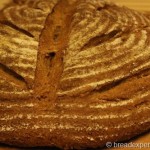Description
Learn to bake Einkorn Bread with an Overnight Sponge! This simple recipe offers tips for kneading, proofing, and baking a soft, flavorful loaf.
Ingredients
Sponge:
- 187 g (1 2/3 cups) Einkorn flour
- 140 g (2/3 cup) water (50 to 55 degrees F.)
- 1/8 tsp instant yeast
Final Dough:
- 210 g (~1 3/4 cups) Einkorn flour (plus more for kneading)
- 327 g Sponge (all of it)
- 140 g (2/3 cup) water (60 to 65 degrees F.)
- 1/2 tsp instant yeast
- 2 tsp salt (~8 grams/2%) or less if desired
Instructions
Prepare the Sponge:
Mix the sponge ingredients 12 to 15 hours before you plan to make the dough. If the temperature is cooler in the house, use warmer water; if it is warmer in the house, use cooler water. The final temperature should be about 65 degrees F.
Cover the sponge and let it rest at room temperature for 12 to 15 hours. The sponge is ready when it appears bubbly and slightly risen.
Mix the Dough:
Combine all of the dough ingredients, including the sponge, in a large mixing bowl until a dough forms. Using a Danish dough whisk, wooden spoon, or dough scraper works well for this step.
Knead the Dough:
Turn the dough out onto a lightly floured surface and knead for about 5–7 minutes, or until it comes together and feels soft and supple. Einkorn dough has a more fragile gluten structure, so it doesn’t require extensive kneading.
If the dough feels too sticky, let it rest (autolyse) on the counter for about 10–15 minutes before kneading to help the gluten develop.
First Rise:
Place the dough in a bowl and cover it with a kitchen towel. Let it rise at room temperature until doubled in bulk, about 1 hour.
Second Rise:
Punch down the dough, fold it, and let it rise again, covered until doubled in bulk again, about 1 hour.
Shape the Loaf:
When the dough is fully risen shape it into a boule (ball) and place it smooth-side-down in a floured banneton basket or a bowl lined with a towel heavily dusted with flour. Ensure the container supports the loaf but allows for expansion. Cover with a towel to prevent the dough from drying out.
Final Proof:
Let the loaf proof until it is soft and full of gas, typically 30 minutes to 1.5 hours depending on room temperature. To check if it’s ready, gently poke the dough with a wet or floured finger. If the dough slowly springs back and feels soft and full of gas, it’s ready to bake. Keep an eye on it, as over-proofing can lead to a flatter loaf.
Prepare the Oven:
Preheat the oven to 500 degrees F. (for about an hour) with a pizza stone on the middle rack and a steam pan underneath.
Bake the Loaf:
Carefully flip the loaf onto parchment paper and score it. If it sticks to the basket, gently coax it out.
Slide the loaf (on the parchment paper) onto the hot baking stone. Add 1 cup of hot water to the steam pan.
Immediately lower the oven temperature to 450 degrees F. Bake for 20–25 minutes, or until the loaf is browned and makes a hollow sound when thumped on the bottom. Remove the parchment paper partway through baking to ensure the bottom gets baked through.
Cool and Serve:
Cool the loaf completely on a wire rack before slicing.
Notes
- Proofing and Kneading Variability: Times for kneading and proofing can vary based on factors like room temperature, humidity, and the specific qualities of your einkorn flour. Use visual and tactile cues (like the poke test) to guide you for the best results.
- Handling Sticky Dough: Einkorn dough tends to be stickier than other flours. Don’t be tempted to over-knead or add too much flour; instead, use resting periods and gentle handling to develop the gluten.
- Category: Artisan Einkorn Bread
- Method: sponge
